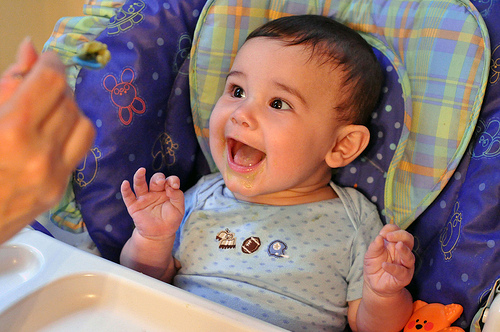
Your own adventures in homemade baby food will be very smooth and easy if you know some simple basics. It took a little thought to figure out how to put these points together into a post. I've decided that a list is the best way to go this time. Below, are the basics of homemade baby food that have helped me along the way so far, although they may not seem to be in a very logical order:
- Books: "Superfoods: For Babies and Children" and "Top 100 Baby Purees" both written by children's nutrition expert, Annabel Karmel. Top 100 Baby Purees is mainly a shortened version of Superfoods. If you are going for one or the other, I recommend Superfoods over Top 100 as it gives more detailed vitamin and nutrition information. It also provides a meal schedule (not that I follow, but is helpful as an example). Additionally, Superfoods continues beyond baby purees and into children's food, so you are getting more bang for your buck! But, again, I have both and thoroughly enjoy them.
- Consider taking a few hours out of one or two days to make a big bulk of baby food to freeze. This is what I do. In one day, I have weeks worth of food. This means, I only have to spend time actually making the food once or twice a month! And, it's SO easy to thaw. (More on freezing baby food in a later post.)
- While traveling or out to dinner, try using a portable food mill. It's super easy to use and cleans up well. The food mill I use doubles as a bowl for the baby and comes with a travel case. I received it as a gift from one of my baby showers, where the mom and her daughter who gave it to me said they used one frequently for their kids.
- Don't shy away from frozen food. Frozen veggies and fruits can be very convenient when prepping baby food. They are just as nutritious as fresh produce, as they are frozen at their peak of freshness and nutrition. Fresh produce can lose nutrients as they sit on the shelf, so sometimes frozen may be better.
- Colors are important. To keep it as simple as possible, remember that a colorful diet is a healthy diet. I always try to switch up the colors of the fruits and veggies I'm feeding to Judah, to make sure he is getting a platter full of nutrients each day.
- Keep a teapot of boiling water on the stove while making your purees. Sometimes the purees need to be thinned to your desired consistency, and the easiest way to do this is to add boiling water.
- Good things to have on hand for feeding your baby homemade baby food:
- Baby spoons
- Bibs
- Baby bowls (I actually use tiny candy bowls that were used at my shower and bought from the dollar store. They are the perfect size for now.)
- High Chair (or start him in a Bumbo chair or bouncer)
- Napkins, paper towels or burp clothes - the feeding process can be a bit messy, especially at first!
- TLC and patience - a lot of Tender, Love and Care is essential as your little one may not want to cooperate and will turn his head, play with his toes, stick his fingers in his mouth, or even try to grab the bowl of food and throw it to the floor. 🙂 It can definitely take a lot of patience.
- When you puree the food, you can use either a food mill, blender, or food processor. These all work equally great. So, if you already have one type of these, don't bother going out and spending money on another.
- Just use store-bought baby cereals. It was easier and more economical for me to just use the store-bought baby cereals. When I reference any cereal, keep in mind it's not homemade. And, while I'm admitting this, I might as well tell you that I also used store bought veggies/fruits during our move from Chicago to California since I didn't have a way to make the food homemade. 🙂
Hopefully the points above are helpful and encouraging to you. Another area, besides how to make baby food, that I've found intimidating when feeding Judah is how much and how often should I feed him? Because I had doubts with this, I know there are other mothers out there struggling with this, too. Therefore, I'm going to share a journal of Judah's feeding schedule with you now, and then I'll post updates to it as it changes. But please remember all babies have different appetites and will be on different schedules.
At 4 Months:
Breakfast - baby oatmeal cereal (started with very little and worked up to 1-2 oz)
Dinner - baby rice cereal (started with very little and worked up to 1-2 oz)
6 oz bottles every 3-4 hours
At 6 Months:
Breakfast - baby oatmeal cereal (2 oz), fruit puree (2-3 oz)
Dinner - baby rice cereal (2 oz), veggie puree (2-3 oz)
6 oz bottles every 3-4 hours
At 7 Months:
Breakfast - baby oatmeal cereal (2-3 oz), fruit puree (2-3 oz)
Lunch - protein: meat or eggs puree (2-4 oz)
Dinner - baby rice cereal (2-3 oz), veggie puree (2-3 oz)
Snacks - once or twice a day (such as cereal puffs and Gerber crunchies)
6 oz bottles every 3-4 hours
Judah is a very good eater. Friends and family joke about how he looks like a little baby bird, opening his mouth wide in anticipation for each spoonful. I'm hoping as he grows up, he will not be a picky eater and he will like many different kinds of food. I think we're at a good start.


